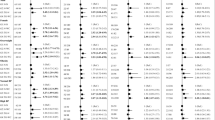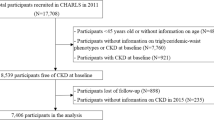Abstract
Objectives:
To determine the prevalence of ‘hypertriglyceridemic waist’ (HTGW) in Oji-Cree, to examine its interaction with hepatic nuclear factor-1α (HNF1A) in association with type 2 diabetes, and to characterize its putative genetic determinants.
Method:
The presence or absence of HTGW was determined in 522 Oji-Cree subjects (223 males, 299 females), ⩾18 years of age, in whom physical measurements and fasting plasma analyte concentrations were gathered, and a 75-g oral glucose tolerance test was administered, as part of a cross-sectional study. Subjects were genotyped for HNF1A codon 319, angiotensinogen (AGT) codons 174 and 235, G-protein β3-subunit (GNB3) nucleotide 825, fatty acid-binding protein (FABP2) codon 54, nucleotides −455 and −482 of the apolipoprotein (apo) C-III (APOC3) promoter, and a 5-bp insertion/deletion polymorphism within the 3′-untranslated region of protein phosphatase 1 regulatory subunit 3 (PPP1R3).
Results:
The unadjusted prevalence of HTGW in Oji-Cree adults was 20.5%, with more males affected than females (27.8 vs 15.1%, P=0.0004). Logistic regression analysis, adjusted for age and gender, showed type 2 diabetes was associated with both HNF1A G319S (odds ratio (OR) 4.85, 95% CI 2.45, 9.58) and HTGW (OR 4.96, 95% CI 2.49, 9.88). When the HNF1A mutation and HTGW were present in combination, the OR for type 2 diabetes was markedly increased (OR 43.2, 95% CI 12.4, 150). In women only, both GNB3 825C>T and FABP2 A54T genotypes were significantly associated with HTGW (OR 2.02, 95% CI 1.01, 4.05 and OR 1.95, 95% CI 1.01, 3.74, respectively).
Conclusions:
HTGW is prevalent in Oji-Cree, especially in men. The ORs for type 2 diabetes were similar (∼5-fold) for subjects with either the presence of HTGW or the private HNF1A G319S mutation. These two independent risk factors acted synergistically to confer an even greater increased risk of type 2 diabetes.
This is a preview of subscription content, access via your institution
Access options
Subscribe to this journal
Receive 12 print issues and online access
$259.00 per year
only $21.58 per issue
Buy this article
- Purchase on Springer Link
- Instant access to full article PDF
Prices may be subject to local taxes which are calculated during checkout
Similar content being viewed by others
References
Executive Summary of The Third Report of The National Cholesterol Education Program (NCEP). Expert panel on detection, evaluation, and treatment of high blood cholesterol in adults (adult treatment panel III). JAMA 2001; 285: 2486–2497.
Laaksonen DE, Lakka HM, Niskanen LK, Kaplan GA, Salonen JT, Lakka TA . Metabolic syndrome and development of diabetes mellitus: application and validation of recently suggested definitions of the metabolic syndrome in a prospective cohort study. Am J Epidemiol 2002; 156: 1070–1077.
Lakka HM, Laaksonen DE, Lakka TA, Niskanen LK, Kumpusalo E, Tuomilehto J et al. The metabolic syndrome and total and cardiovascular disease mortality in middle-aged men. JAMA 2002; 288: 2709–2716.
Lamarche B, Tchernof A, Mauriege P, Cantin B, Dagenais GR, Lupien PJ et al. Fasting insulin and apolipoprotein B levels and low-density lipoprotein particle size as risk factors for ischemic heart disease. JAMA 1998; 279: 1955–1961.
Lemieux I, Pascot A, Couillard C, Lamarche B, Tchernof A, Almeras N et al. Hypertriglyceridemic waist: a marker of the atherogenic metabolic triad (hyperinsulinemia; hyperapolipoprotein B; small, dense LDL) in men? Circulation 2000; 102: 179–184.
Bell D, McAuley KA, Mann J, Murphy E, Williams S . The hypertriglyceridaemic waist in New Zealand Maori. Asia Pac J Clin Nutr 2004; 13: 74–77.
LaMonte MJ, Ainsworth BE, DuBose KD, Grandjean PW, Davis PG, Yanowitz FG et al. The hypertriglyceridemic waist phenotype among women. Atherosclerosis 2003; 171: 123–130.
Lemieux I, Almeras N, Mauriege P, Blanchet C, Dewailly E, Bergeron J et al. Prevalence of ‘hypertriglyceridemic waist’ in men who participated in the Quebec Health Survey: association with atherogenic and diabetogenic metabolic risk factors. Can J Cardiol 2002; 18: 725–732.
Bos G, Dekker JM, Heine RJ . Non-HDL cholesterol contributes to the ‘hypertriglyceridemic waist’ as a cardiovascular risk factor: the Hoorn study. Diabetes Care 2004; 27: 283–284.
Young TK, Reading J, Elias B, O'Neil JD . Type 2 diabetes mellitus in Canada's first nations: status of an epidemic in progress. CMAJ 2000; 163: 561–566.
Harris SB, Gittelsohn J, Hanley A, Barnie A, Wolever TM, Gao J et al. The prevalence of NIDDM and associated risk factors in native Canadians. Diabetes Care 1997; 20: 185–187.
Hegele RA, Cao H, Harris SB, Hanley AJ, Zinman B . The hepatic nuclear factor-1alpha G319S variant is associated with early-onset type 2 diabetes in Canadian Oji-Cree. J Clin Endocrinol Metab 1999; 84: 1077–1082.
Triggs-Raine BL, Kirkpatrick RD, Kelly SL, Norquay LD, Cattini PA, Yamagata K et al. HNF-1alpha G319S, a transactivation-deficient mutant, is associated with altered dynamics of diabetes onset in an Oji-Cree community. Proc Natl Acad Sci USA 2002; 99: 4614–4619.
Gittelsohn J, Wolever TM, Harris SB, Harris-Giraldo R, Hanley AJ, Zinman B . Specific patterns of food consumption and preparation are associated with diabetes and obesity in a Native Canadian community. J Nutr 1998; 128: 541–547.
Kriska AM, Hanley AJ, Harris SB, Zinman B . Physical activity, physical fitness, and insulin and glucose concentrations in an isolated Native Canadian population experiencing rapid lifestyle change. Diabetes Care 2001; 24: 1787–1792.
Shah BR, Hux JE, Zinman B . Increasing rates of ischemic heart disease in the native population of Ontario, Canada. Arch Intern Med 2000; 160: 1862–1866.
Pollex RL, Hanley AJG, Zinman B, Harris SB, Khan HMR, Hegele R . Synergism between mutant HNF1A and the metabolic syndrome in Oji-Cree type 2 diabetes. Diabet Med 2005; 22: 1510–1515.
Pollex RL, Hanley AJG, Zinman B, Harris SB, Khan HMR, Hegele R . Metabolic syndrome in aboriginal Canadians: prevalence and genetic associations. Atherosclerosis 2005 (in press) [Epub ahead of print] PMID: 15869758.
Hanley AJG, Harris SB, Barnie A, Gittelsohn J, Wolever TMS, Logan A et al. The Sandy Lake Health and Diabetes Project: design, methods and lessons learned. Chronic Dis Canada 1995; 16: 149–156.
Hanley AJ, Harris SB, Gao XJ, Kwan J, Zinman B . Serum immunoreactive leptin concentrations in a Canadian aboriginal population with high rates of NIDDM. Diabetes Care 1997; 20: 1408–1415.
Hegele RA, Harris SB, Hanley AJ, Sun F, Connelly PW, Zinman B . Angiotensinogen gene variation associated with variation in blood pressure in aboriginal Canadians. Hypertension 1997; 29: 1073–1077.
Hegele RA, Harris SB, Hanley AJ, Cao H, Zinman B . G protein beta3 subunit gene variant and blood pressure variation in Canadian Oji-Cree. Hypertension 1998; 32: 688–692.
Hegele RA, Harris SB, Hanley AJ, Sadikian S, Connelly PW, Zinman B . Genetic variation of intestinal fatty acid-binding protein associated with variation in body mass in aboriginal Canadians. J Clin Endocrinol Metab 1996; 81: 4334–4337.
Hegele RA, Connelly PW, Hanley AJ, Sun F, Harris SB, Zinman B . Common genomic variation in the APOC3 promoter associated with variation in plasma lipoproteins. Arterioscler Thromb Vasc Biol 1997; 17: 2753–2758.
Hegele RA, Harris SB, Zinman B, Wang J, Cao H, Hanley AJ et al. Variation in the AU(AT)-rich element within the 3′-untranslated region of PPP1R3 is associated with variation in plasma glucose in aboriginal Canadians. J Clin Endocrinol Metab 1998; 83: 3980–3983.
Hill WG, Robertson A . Linkage disequilibrium in finite populations. Theor Appl Genet 1968; 38: 226–231.
Lemieux S, Prud'homme D, Bouchard C, Tremblay A, Despres JP . A single threshold value of waist girth identifies normal-weight and overweight subjects with excess visceral adipose tissue. Am J Clin Nutr 1996; 64: 685–693.
Yusuf S, Hawken S, Ounpuu S, Dans T, Avezum A, Lanas F et al. Effect of potentially modifiable risk factors associated with myocardial infarction in 52 countries (the INTERHEART study): case–control study. Lancet 2004; 364: 937–952.
Jemaa R, Tuzet S, Portos C, Betoulle D, Apfelbaum M, Fumeron F . Lipoprotein lipase gene polymorphisms: associations with hypertriglyceridemia and body mass index in obese people. Int J Obes Relat Metab Disord 1995; 19: 270–274.
Baier LJ, Bogardus C, Sacchettini JC . A polymorphism in the human intestinal fatty acid binding protein alters fatty acid transport across Caco-2 cells. J Biol Chem 1996; 271: 10892–10896.
Baier LJ, Sacchettini JC, Knowler WC, Eads J, Paolisso G, Tataranni PA et al. An amino acid substitution in the human intestinal fatty acid binding protein is associated with increased fatty acid binding, increased fat oxidation, and insulin resistance. J Clin Invest 1995; 95: 1281–1287.
Hegele RA, Connelly PW, Hanley AJ, Sun F, Harris SB, Zinman B . Common genomic variants associated with variation in plasma lipoproteins in young aboriginal Canadians. Arterioscler Thromb Vasc Biol 1997; 17: 1060–1066.
Siffert W, Rosskopf D, Siffert G, Busch S, Moritz A, Erbel R et al. Association of a human G-protein beta3 subunit variant with hypertension. Nat Genet 1998; 18: 45–48.
Siffert W, Forster P, Jockel KH, Mvere DA, Brinkmann B, Naber C et al. Worldwide ethnic distribution of the G protein beta3 subunit 825T allele and its association with obesity in Caucasian, Chinese, and Black African individuals. J Am Soc Nephrol 1999; 10: 1921–1930.
Yamamoto M, Abe M, Jin JJ, Wu Z, Tabara Y, Mogi M et al. Association of GNB3 gene with pulse pressure and clustering of risk factors for cardiovascular disease in Japanese. Biochem Biophys Res Commun 2004; 316: 744–748.
Acknowledgements
We thank Matthew Ban for his assistance in preparing the databases for analysis. We also gratefully acknowledge the chief, council and community members of Sandy Lake First Nation and the Sandy Lake community surveyors (Louisa Kakegamic, Tina Noon, Madeline Kakegamic, Elda Anishinabie, Annette Rae, Connie Kakegamic, and Mary Mamakeesick), whose partnership and co-operation was essential in the design and implementation of this project. RAH holds a Canada Research Chair (Tier I) and is a Career Investigator of the Heart and Stroke Foundation of Ontario. RLP is supported by a Natural Sciences and Engineering Research Council of Canada Graduate Scholarship and the Canadian Institute of Health Research Strategic Training Program in Vascular Research. AJGH was supported through a Canadian Diabetes Scholarship and a University of Toronto Banting and Best Diabetes Centre New Investigator Award. SBH is a Career Scientist of the Ontario Ministry of Health.
Author information
Authors and Affiliations
Corresponding author
Rights and permissions
About this article
Cite this article
Pollex, R., Hanley, A., Zinman, B. et al. Clinical and genetic associations with hypertriglyceridemic waist in a Canadian aboriginal population. Int J Obes 30, 484–491 (2006). https://doi.org/10.1038/sj.ijo.0803152
Received:
Revised:
Accepted:
Published:
Issue Date:
DOI: https://doi.org/10.1038/sj.ijo.0803152
Keywords
This article is cited by
-
Hypertriglyceridemic waist phenotype and abnormal glucose metabolism: a system review and meta-analysis
Endocrine (2019)
-
Genome- and epigenome-wide association study of hypertriglyceridemic waist in Mexican American families
Clinical Epigenetics (2016)
-
Association Between the Hypertriglyceridemic Waist Phenotype, Prediabetes, and Diabetes Mellitus Among Adults in Puerto Rico
Journal of Immigrant and Minority Health (2016)
-
Hypertriglyceridemic-waist phenotype predicts diabetes: a cohort study in Chinese urban adults
BMC Public Health (2012)
-
Gene–environment interaction and the GNB3 gene in the Atherosclerosis Risk in Communities Study
International Journal of Obesity (2007)



